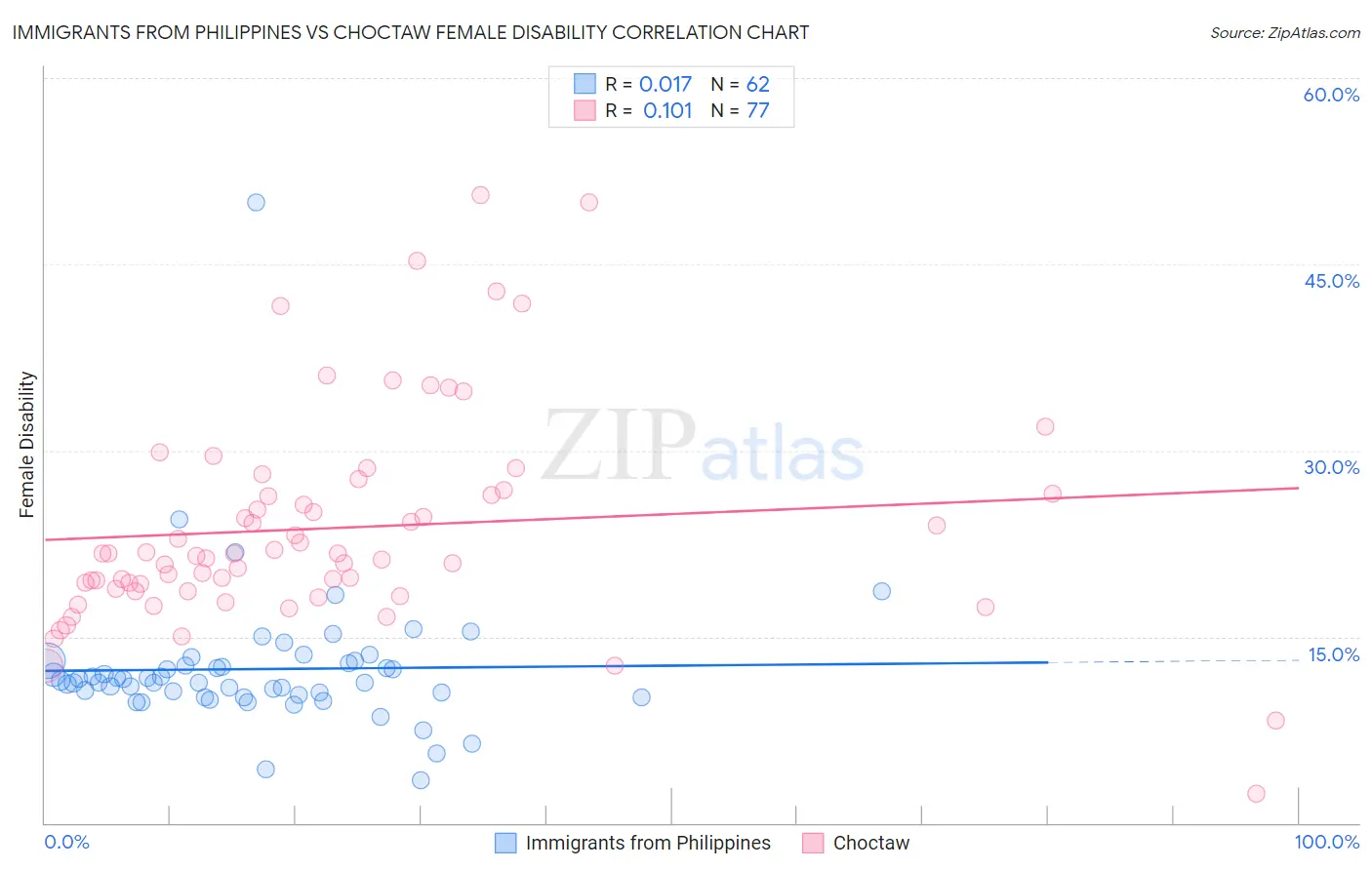Immigrants from Philippines vs Choctaw Female Disability
COMPARE
Immigrants from Philippines
Choctaw
Female Disability
Female Disability Comparison
Immigrants from Philippines
Choctaw
11.7%
FEMALE DISABILITY
98.6/ 100
METRIC RATING
99th/ 347
METRIC RANK
15.4%
FEMALE DISABILITY
0.0/ 100
METRIC RATING
341st/ 347
METRIC RANK
Immigrants from Philippines vs Choctaw Female Disability Correlation Chart
The statistical analysis conducted on geographies consisting of 471,161,268 people shows no correlation between the proportion of Immigrants from Philippines and percentage of females with a disability in the United States with a correlation coefficient (R) of 0.017 and weighted average of 11.7%. Similarly, the statistical analysis conducted on geographies consisting of 269,656,358 people shows a poor positive correlation between the proportion of Choctaw and percentage of females with a disability in the United States with a correlation coefficient (R) of 0.101 and weighted average of 15.4%, a difference of 31.7%.

Female Disability Correlation Summary
| Measurement | Immigrants from Philippines | Choctaw |
| Minimum | 3.4% | 2.4% |
| Maximum | 50.0% | 50.6% |
| Range | 46.6% | 48.2% |
| Mean | 12.4% | 23.8% |
| Median | 11.4% | 21.7% |
| Interquartile 25% (IQ1) | 10.3% | 18.8% |
| Interquartile 75% (IQ3) | 12.8% | 26.7% |
| Interquartile Range (IQR) | 2.6% | 7.9% |
| Standard Deviation (Sample) | 5.9% | 8.7% |
| Standard Deviation (Population) | 5.9% | 8.6% |
Similar Demographics by Female Disability
Demographics Similar to Immigrants from Philippines by Female Disability
In terms of female disability, the demographic groups most similar to Immigrants from Philippines are Immigrants from Uruguay (11.7%, a difference of 0.050%), Immigrants from Costa Rica (11.7%, a difference of 0.070%), Immigrants from South Eastern Asia (11.7%, a difference of 0.080%), Immigrants from Eastern Africa (11.7%, a difference of 0.15%), and Immigrants from Western Asia (11.7%, a difference of 0.16%).
| Demographics | Rating | Rank | Female Disability |
| Immigrants | Czechoslovakia | 99.5 /100 | #92 | Exceptional 11.6% |
| Immigrants | Sierra Leone | 99.4 /100 | #93 | Exceptional 11.6% |
| Immigrants | Brazil | 99.4 /100 | #94 | Exceptional 11.6% |
| Immigrants | Northern Europe | 99.4 /100 | #95 | Exceptional 11.6% |
| Immigrants | Russia | 99.0 /100 | #96 | Exceptional 11.7% |
| Koreans | 99.0 /100 | #97 | Exceptional 11.7% |
| Uruguayans | 98.8 /100 | #98 | Exceptional 11.7% |
| Immigrants | Philippines | 98.6 /100 | #99 | Exceptional 11.7% |
| Immigrants | Uruguay | 98.5 /100 | #100 | Exceptional 11.7% |
| Immigrants | Costa Rica | 98.4 /100 | #101 | Exceptional 11.7% |
| Immigrants | South Eastern Asia | 98.4 /100 | #102 | Exceptional 11.7% |
| Immigrants | Eastern Africa | 98.3 /100 | #103 | Exceptional 11.7% |
| Immigrants | Western Asia | 98.3 /100 | #104 | Exceptional 11.7% |
| Australians | 98.3 /100 | #105 | Exceptional 11.7% |
| Immigrants | Greece | 98.2 /100 | #106 | Exceptional 11.7% |
Demographics Similar to Choctaw by Female Disability
In terms of female disability, the demographic groups most similar to Choctaw are Chickasaw (15.2%, a difference of 1.4%), Creek (15.7%, a difference of 1.6%), Lumbee (15.8%, a difference of 2.3%), Colville (15.1%, a difference of 2.3%), and Kiowa (15.8%, a difference of 2.5%).
| Demographics | Rating | Rank | Female Disability |
| Immigrants | Azores | 0.0 /100 | #333 | Tragic 14.9% |
| Cherokee | 0.0 /100 | #334 | Tragic 14.9% |
| Cajuns | 0.0 /100 | #335 | Tragic 14.9% |
| Seminole | 0.0 /100 | #336 | Tragic 15.0% |
| Tohono O'odham | 0.0 /100 | #337 | Tragic 15.0% |
| Dutch West Indians | 0.0 /100 | #338 | Tragic 15.0% |
| Colville | 0.0 /100 | #339 | Tragic 15.1% |
| Chickasaw | 0.0 /100 | #340 | Tragic 15.2% |
| Choctaw | 0.0 /100 | #341 | Tragic 15.4% |
| Creek | 0.0 /100 | #342 | Tragic 15.7% |
| Lumbee | 0.0 /100 | #343 | Tragic 15.8% |
| Kiowa | 0.0 /100 | #344 | Tragic 15.8% |
| Puerto Ricans | 0.0 /100 | #345 | Tragic 16.6% |
| Tsimshian | 0.0 /100 | #346 | Tragic 16.8% |
| Houma | 0.0 /100 | #347 | Tragic 16.9% |